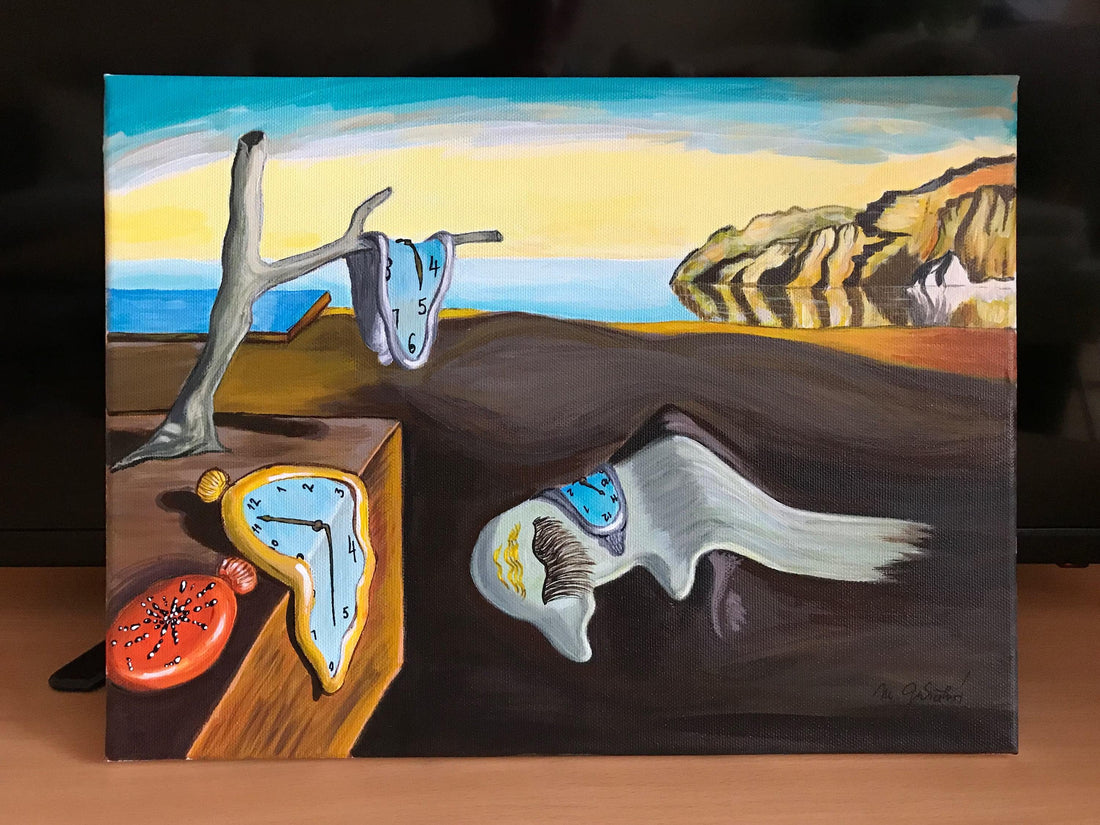
What is the Meaning Behind Salvador Dali's Melting Clocks: An Exploration
Share
What is the Meaning Behind Salvador Dali's Melting Clocks: An Exploration
The Painting: Persistence of Memory
The Persistence of Memory is a 1931 painting by Salvador Dali, a renowned surrealist artist. The painting is one of the most recognizable works of Surrealism and is widely referred to in popular culture. Dalí's idea for the melting clocks came while observing Camembert cheese melting in the sun, symbolizing the fluidity and subjective nature of time. The painting features melting clocks, which epitomize Dalí’s theory of “softness” and “hardness” and symbolize the relativity of space and time.
Dali's painting is part of the collection of the Museum of Modern Art (MoMA) in New York City and has been there since 1934.
Dali's distinctive style is evident in this work. Dalí's art, particularly his melting clocks from The Persistence of Memory, emphasizes their symbolic representation of fluid time and the complexities of human perception. The melting watches are iconic symbols of surrealism. The painting depicts distorted clocks in a barren landscape, conveying themes related to time, perception, and the subconscious.
Salvador Dalí's The Persistence of Memory has become a cultural touchstone across various media, challenging perceptions of time. Salvador Dalí's The Persistence of Memory has become a cultural touchstone across various media, challenging perceptions of time. The soft watches are displayed on various surfaces within the painting, contributing to its surreal and dreamlike atmosphere.
Dali’s Artistic Techniques and Style
Salvador Dalí’s artistic techniques and style played a significant role in the creation of “The Persistence of Memory.” Dalí was renowned for his unique approach to art, which seamlessly blended realism with fantasy, creating a dreamlike quality that captivated viewers. He employed a range of techniques, including oil painting, watercolor, and collage, to craft his distinctive works.
One of Dalí’s most notable techniques was his use of the “paranoiac-critical method.” This innovative approach involved inducing self-hypnosis to access his subconscious mind, allowing him to tap into his deepest fears and desires. The result was art that was both intensely personal and universally resonant. In “The Persistence of Memory,” this method is evident in the surreal and fluid depiction of time through the melting clocks.
Dalí’s style was also characterized by his use of rich symbolism and metaphor. The melting clocks in the painting represent the fluidity of time and its distortion by the human mind. They symbolize the human experience, illustrating how time can be affected by our memories and experiences. This symbolic approach invites viewers to interpret the clocks in various ways, making them subjective and deeply personal symbols.
Influenced by a range of sources, including Renaissance art, Cubism, and Surrealism, Dalí’s work was marked by meticulous attention to detail and a profound exploration of the human psyche. He admired Leonardo da Vinci, seeing him as a kindred spirit in the pursuit of blending art and science. Dalí’s paintings, including “The Persistence of Memory,” reflect this blend of influences, showcasing his unique ability to merge the real with the fantastical.
Historical Context of the Painting
“The Persistence of Memory” was painted in 1931, a period of significant change and upheaval in Europe. The rise of Fascism and Nazism was casting a dark shadow over the continent, prompting many artists to respond with works that were both deeply personal and politically charged.
During this tumultuous time, Dalí had recently joined the Surrealist movement, which was founded by André Breton in 1924. The movement emphasized the exploration of the subconscious mind and a rejection of traditional notions of art and reality. This new artistic direction resonated with Dalí, who saw it as an opportunity to delve into the deepest recesses of his own mind and create works that transcended conventional boundaries.
Dalí’s experiences with the Surrealist movement profoundly influenced his work during this period. The movement’s focus on the subconscious mind and its embrace of irrationality and dream states provided Dalí with the perfect framework to explore his own psyche. “The Persistence of Memory” is a testament to this exploration, with its melting clocks and dreamlike landscape reflecting the fluid and subjective nature of time and reality.
By understanding the historical context in which “The Persistence of Memory” was painted, we gain a deeper appreciation for Dalí’s work. It becomes clear that the painting is not just a surreal depiction of time but also a reflection of the broader social and political upheavals of the era, as well as Dalí’s personal journey through the realms of the subconscious.
Symbolism and Interpretation of Melting Clocks
Salvador Dalí’s melting clocks in The Persistence of Memory are often seen as symbols of the fluidity of time, particularly in dreams.
The clocks could also signify the mutability of temporal reality, and indicate experiences of the past, present, and future.
Dalí himself said that the clocks were inspired by melting Camembert cheese.
Each human can interpret the clocks in various ways, making them subjective symbols. Some interpretations suggest that the abstract forms depicted in the painting may serve as a self-portrait of the artist, embodying his unique vision and psychological state.
The melting clocks represent the omnipresence of time, and identify its mastery over human beings.
Cultural Significance and Legacy of Melting Clocks Represent
-
Salvador Dalí’s The Persistence of Memory has become one of the most iconic images in art history, influencing popular culture.
-
The surreal depiction of time as soft, flowing, and malleable has resonated in various forms of media.
-
Examples of the melting clock’s influence include film, music, fashion, video games, and advertising.
-
The melting clock is a lasting symbol of how time can be seen as fluid and subjective.
-
Dalí’s art often features familiar objects in unfamiliar ways, embracing irrationality, and his “paranoiac-critical” method involved self-induced paranoia and hallucinations to create art.
